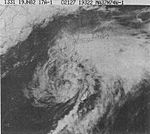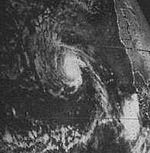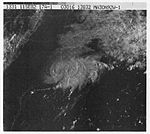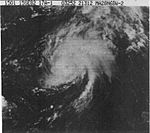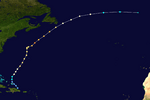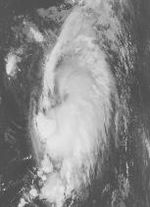1982 Atlantic hurricane season facts for kids
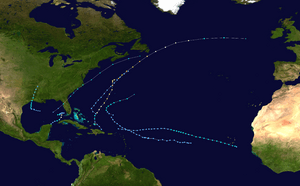 |
|
| Season summary map | |
| First storm formed | June 1, 1982 |
|---|---|
| Last storm dissipated | October 3, 1982 |
| Strongest storm | Debby – 950 mbar (hPa) (28.06 inHg), 130 mph (215 km/h) |
| Total depressions | 9 |
| Total storms | 6 |
| Hurricanes | 2 |
| Major hurricanes (Cat. 3+) | 1 |
| Total fatalities | 29 |
| Total damage | $100 million (1982 USD) |
| Atlantic hurricane seasons 1980, 1981, 1982, 1983, 1984 |
|
The 1982 Atlantic hurricane season was a time when tropical cyclones formed in the Atlantic Ocean. It officially started on June 1, 1982, and finished on November 30, 1982. During this season, six storms were strong enough to get names, and two of them became hurricanes.
Most of the storms were not very strong. However, Tropical Storm Beryl caused the most deaths, with 115 people losing their lives as it moved across the Caribbean Sea.
Contents
Storms of 1982
Hurricane Alberto's Path
| Category 1 hurricane (SSHS) | |||
|---|---|---|---|
|
|||
| Duration | June 1 – June 6 | ||
| Intensity | 85 mph (140 km/h) (1-min), 985 mbar (hPa) | ||
A tropical depression started near western Cuba on June 1. It grew from a group of thunderstorms. The storm slowly moved northeast through the Gulf of Mexico. On June 3, it became Tropical Storm Alberto.
Alberto traveled northeast on a path that was hard to predict. For a short time, it even became a Category 1 hurricane. This was one of the earliest hurricanes to form in June. Alberto then quickly weakened back into a tropical storm. It moved west again and ended near the Florida Keys, Florida, on June 6.
Even though Alberto did not hit land, it caused 23 deaths in Cuba due to heavy flooding. Southern Florida also got a lot of rain. One place, Tavernier, received over 16 inches of rain.
Subtropical Storm One's Journey
| Tropical storm (SSHS) | |||
|---|---|---|---|
|
|||
| Duration | June 18 – June 20 | ||
| Intensity | 70 mph (110 km/h) (1-min), 984 mbar (hPa) | ||
The first subtropical storm of the season formed on June 18. It started in the eastern part of the Gulf of Mexico. This storm moved almost straight northeast for its entire life. It crossed the Florida peninsula that night. This caused warnings for severe thunderstorms and tornadoes.
The storm kept going, crossing the Outer Banks of North Carolina. It stayed strong until June 20. Then, it changed into an extratropical cyclone near Newfoundland.
Subtropical Storm One caused three deaths in Florida. It also sank a fishing boat off the coast of North Carolina. The storm caused about $10 million in damage in 1982. This would be about $20 million in 2005.
Tropical Storm Beryl's Impact
| Tropical storm (SSHS) | |||
|---|---|---|---|
|
|||
| Duration | August 28 – September 6 | ||
| Intensity | 70 mph (110 km/h) (1-min), 988 mbar (hPa) | ||
Beryl became a tropical storm on August 28. It was southeast of the Cape Verde islands. The storm moved slowly west-northwest. At one point, it almost became a hurricane.
While it was in the middle of the Atlantic on September 2, it weakened to a tropical depression. The depression continued west. Its circulation then fell apart on September 6. This happened just north of the Windward Islands.
Beryl caused 115 deaths in the Cape Verde islands. These islands are not usually hit by hurricanes. However, another tropical storm, Fran, hit the islands in 1984. Fran caused 31 deaths.
Tropical Storm Chris's Landfall
| Tropical storm (SSHS) | |||
|---|---|---|---|
|
|||
| Duration | September 9 – September 13 | ||
| Intensity | 65 mph (100 km/h) (1-min), 994 mbar (hPa) | ||
A non-tropical low-pressure system formed on September 8. It was in the Gulf of Mexico. It moved west, and the next day it became a subtropical depression. Another low-pressure system guided it north.
The depression slowly got more organized. It strengthened into Tropical Storm Chris on September 10. The storm had winds of 65 mph (100 km/h) before it moved onto land. This happened near Sabine Pass in Louisiana. Chris kept moving inland until it ended over central Arkansas on September 13.
Before Chris hit land, about 6,500 people left southern Louisiana. Many oil workers also moved away from the coast. Chris caused about $2 million in damages in 1982.
Hurricane Debby's Strength
| Category 4 hurricane (SSHS) | |||
|---|---|---|---|
|
|||
| Duration | September 13 – September 20 | ||
| Intensity | 130 mph (215 km/h) (1-min), 950 mbar (hPa) | ||
Debby started as a tropical wave that weakened after leaving Africa. The wave traveled across the Atlantic. It became a tropical depression off the northern coast of Haiti on September 13. The depression turned north and grew stronger. It became a tropical storm and then a hurricane.
Hurricane Debby moved north-northeast. It brought tropical storm-force winds to Bermuda. It kept getting stronger as it moved north. Its strongest winds reached 135 mph (220 km/h). Tropical storm-force winds were also felt at Cape Race in Newfoundland. This happened when Debby passed by on September 18.
The storm then started to speed up and weaken. This was because it moved over the colder waters of the north Atlantic. Debby joined with a strong non-tropical system over the British Isles on September 20.
The weather system that became Debby dropped a lot of rain on Puerto Rico. One area in the southwest of the island got over 12 inches of rain. Debby caused only minor damage.
Tropical Storm Ernesto's End
| Tropical storm (SSHS) | |||
|---|---|---|---|
|
|||
| Duration | September 30 – October 3 | ||
| Intensity | 70 mph (110 km/h) (1-min), 997 mbar (hPa) | ||
A tropical wave formed off the coast of Africa on September 23. The western part of this wave grew bigger. It was named Tropical Depression Six on September 30. The depression got stronger and made a sharp turn on October 1.
An Air Force plane found winds of 40 mph and a pressure of 1003 mbar. The depression was then named Ernesto. A second Air Force plane on October 2 found winds of 70 mph and a pressure of 997 mbar. By October 3, Ernesto was no longer a storm. It had combined with an extratropical low. Ernesto never came near land and caused no damage.
Related Pages
|
Tropical cyclones of the 1982 Atlantic hurricane season |
|||||||||||||||||||||||||
|
|
||||||||||||||||||||||||
|
|
|||||||||||||||||||||||||
|
See also
 In Spanish: Temporada de huracanes en el Atlántico de 1982 para niños
In Spanish: Temporada de huracanes en el Atlántico de 1982 para niños




